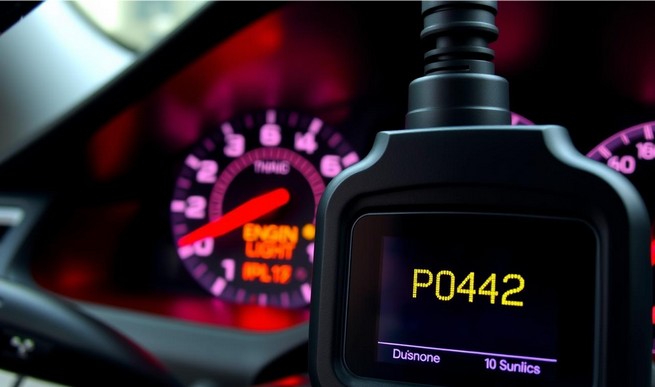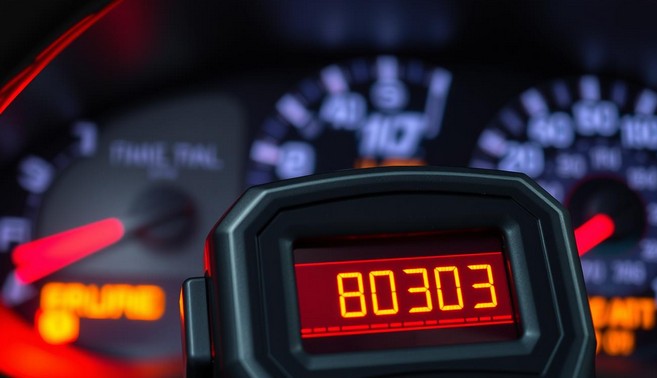When your check engine light illuminates and your diagnostic scanner shows a P0442 code, you're dealing with an evaporative emission control system leak. This common issue affects vehicles of all makes and models, from Toyota and Ford to BMW and Chevrolet. While not immediately threatening to your vehicle's operation, this code indicates an environmental concern that requires attention. In this comprehensive guide, we'll walk you through understanding, diagnosing, and fixing a P0442 control system leak, helping you decide whether to tackle the repair yourself or seek professional assistance.
What Does P0442 Mean?
The P0442 code specifically indicates that your vehicle's computer has detected a small leak in the Evaporative Emission Control (EVAP) system. This system is designed to prevent fuel vapors from escaping into the atmosphere, which helps reduce harmful emissions and improve overall fuel efficiency.
Your vehicle's EVAP system works by capturing fuel vapors from the fuel tank and storing them in a charcoal canister. When the engine is running under specific conditions, these vapors are purged from the canister and burned in the engine through a process controlled by the purge valve. The vehicle's power control module (PCM) regularly tests this system for leaks by creating pressure or vacuum and monitoring whether that pressure/vacuum holds.
When the PCM detects a small leak (typically equivalent to a hole about 0.040 inches in diameter), it triggers the P0442 code. While this is classified as a "small" leak, it's still significant enough to cause environmental concerns and potentially affect your vehicle's performance over time.
Common Causes of P0442 Code
Several components in your vehicle's EVAP system can fail and trigger the P0442 code. Understanding these potential causes can help you narrow down your diagnostic approach:
Loose or damaged fuel cap: The most common and easiest-to-fix cause of a P0442 code is a fuel cap that's either loose, damaged, or doesn't seal properly. The gas cap creates an airtight seal that maintains pressure in the fuel system.
Cracked or damaged EVAP hoses: The EVAP system contains numerous hoses that can develop cracks or holes over time, especially due to heat exposure and normal aging of rubber components.
Faulty purge valve or vent valve: These valves control the flow of fuel vapors within the EVAP system. When they fail to open or close properly, they can trigger the P0442 code.
Damaged charcoal canister: The canister that stores fuel vapors can develop cracks or become saturated over time, preventing it from properly containing vapors.
Leaking fuel tank or filler neck: In some cases, the fuel tank itself or the filler neck may develop small cracks or holes that allow vapors to escape.
Faulty EVAP pressure sensor: The sensor that monitors pressure in the system can provide false readings if it malfunctions.
|
Severity Level |
Symptoms |
Environmental Impact |
Repair Urgency |
|
Low |
Check engine light only |
Minimal fuel vapor release |
Can drive safely, fix within 2-4 weeks |
|
Medium |
Check engine light, occasional fuel smell |
Moderate fuel vapor release |
Fix within 1-2 weeks |
|
High |
Check engine light, strong fuel smell, reduced fuel efficiency |
Significant fuel vapor release |
Fix immediately |
Symptoms of a P0442 Control System Leak
Unlike some vehicle issues that immediately affect performance, a P0442 code may not present obvious symptoms beyond the illuminated check engine light. However, you might notice:
Illuminated check engine light: This is often the only noticeable symptom and what prompts most drivers to check for trouble codes.
Fuel odor: You may notice the smell of gasoline, particularly after refueling or when the vehicle has been parked in a closed space like a garage.
Decreased fuel efficiency: In some cases, you might experience reduced gas mileage as fuel vapors escape rather than being burned in the engine.
Failed emissions test: A vehicle with an active P0442 code will typically fail an emissions inspection.
Rough idling: In rare cases, especially if the leak affects the air-fuel mixture, you might notice the engine running roughly when idling.
Difficulty starting: Though uncommon with small EVAP leaks, severe cases might lead to starting issues due to pressure problems in the fuel system.
Diagnostic Steps for P0442 Code
Diagnosing the exact cause of a P0442 code requires a systematic approach. Follow these steps to identify the source of your EVAP system leak:
1. Check the Fuel Cap
Always start with the simplest potential cause. Remove your fuel cap and inspect it for damage, cracks, or a worn gasket. Reinstall it properly, making sure it clicks several times when tightening. Clear the code and drive for a few days to see if the check engine light returns.
2. Visual Inspection
Perform a thorough visual inspection of all accessible EVAP system components. Look for:
Cracked or damaged hoses and tubes
Loose connections between components
Damaged charcoal canister
Corroded or damaged fuel tank and filler neck
Need Professional Diagnostic Help?
Finding EVAP leaks can be challenging without proper equipment. Many auto parts stores offer free diagnostic scanning services that can help confirm the P0442 code.
3. Smoke Test Procedure
A smoke test is one of the most effective ways to locate small EVAP system leaks. This procedure involves introducing smoke into the sealed system and watching for where it escapes:
Ensure the vehicle is cool and not running
Connect a smoke machine to the EVAP system test port or fuel tank
Introduce smoke into the system while maintaining slight pressure
Use a flashlight to inspect all EVAP components for escaping smoke
Pay special attention to connection points and areas with hoses or tubes
Mark any identified leak points for repair
4. Pressure/Vacuum Testing
Another effective diagnostic method is to perform a pressure or vacuum test on the EVAP system:
Connect a pressure tester to the fuel system
Pressurize the system according to manufacturer specifications
Monitor the pressure gauge for any drops, indicating a leak
Use soapy water on suspected leak areas and look for bubbles
Repair Solutions for P0442 Code
Once you've identified the source of the leak, you can proceed with the appropriate repair. Here are the most common solutions based on the diagnosed issue:
Replacing the Fuel Cap
If your inspection revealed a damaged or ill-fitting fuel cap, simply replace it with an OEM (Original Equipment Manufacturer) or high-quality aftermarket cap designed for your specific vehicle model. This is the least expensive and easiest repair.
Repairing or Replacing EVAP Hoses
For damaged hoses, replacement is typically the best option. While temporary repairs using specialized tape might work in emergencies, they're not recommended as permanent solutions. Always use hoses that meet or exceed OEM specifications.
Replacing Purge or Vent Valves
Faulty valves will need replacement. These components are typically bolted or clipped in place and connected to the vehicle's electrical system. Consult your vehicle's service manual for the exact location and replacement procedure.
Charcoal Canister Replacement
If the charcoal canister is damaged or saturated, it will need to be replaced. This component is usually located near the fuel tank and may require significant disassembly to access.
|
Component |
DIY Cost |
Professional Repair Cost |
Repair Difficulty |
|
Fuel Cap |
$15-$50 |
$50-$100 |
Very Easy |
|
EVAP Hoses |
$20-$100 |
$150-$300 |
Moderate |
|
Purge Valve |
$30-$120 |
$150-$350 |
Moderate |
|
Vent Valve |
$40-$150 |
$175-$400 |
Moderate to Difficult |
|
Charcoal Canister |
$150-$500 |
$300-$800 |
Difficult |
|
Component |
OEM Parts |
Aftermarket Parts |
Recommendation |
|
Fuel Cap |
Higher cost, guaranteed fit |
Lower cost, variable quality |
OEM recommended for proper seal |
|
EVAP Hoses |
Exact fit, higher durability |
May require modification |
High-quality aftermarket acceptable |
|
Purge/Vent Valves |
Reliable, exact specifications |
Variable quality, lower cost |
OEM recommended for reliability |
|
Charcoal Canister |
Perfect fit, highest quality |
Significant cost savings |
OEM for long-term reliability |
Need Professional EVAP System Repair?
Complex EVAP system repairs often require specialized tools and expertise. Find certified mechanics in your area who specialize in emissions system repairs.
Prevention Tips for EVAP System Issues
Preventing future P0442 codes and maintaining your EVAP system in good condition can save you time and money. Follow these preventive maintenance tips:
Properly tighten your fuel cap: Always ensure your fuel cap clicks several times when tightening after refueling.
Regular inspections: Periodically check visible EVAP components for signs of wear, cracks, or damage.
Quality fuel: Use high-quality fuel from reputable stations to reduce the risk of contaminants affecting your EVAP system.
Avoid overfilling: Don't continue fueling after the pump automatically shuts off, as this can saturate the charcoal canister.
Address check engine lights promptly: Early intervention can prevent small issues from becoming more significant problems.
Follow maintenance schedule: Adhere to your vehicle manufacturer's recommended maintenance schedule for emissions system checks.
Regular attention to your vehicle's EVAP system not only helps prevent check engine lights but also contributes to environmental protection by ensuring fuel vapors are properly contained and processed. Additionally, a well-maintained EVAP system contributes to optimal fuel efficiency and can extend the life of related components.
Frequently Asked Questions About P0442 Code
Is it safe to drive with a P0442 code?
Yes, it is generally safe to drive with a P0442 code. This code indicates a small leak in the EVAP system, which doesn't directly affect your vehicle's drivability or safety. However, you should plan to address the issue within a reasonable timeframe to prevent environmental harm, potential fuel odors, and to ensure you can pass emissions testing if required in your area.
Can a loose gas cap trigger P0442?
Yes, a loose, damaged, or improperly sealed gas cap is one of the most common causes of the P0442 code. The fuel cap creates an airtight seal that maintains pressure in the fuel system. When this seal is compromised, the vehicle's computer detects the pressure loss and triggers the code. Always check your fuel cap first when troubleshooting this code, as it's the easiest and least expensive potential fix.
How urgent is this repair?
A P0442 code is considered a low to medium urgency repair. The vehicle will continue to operate normally, but the issue should be addressed within a few weeks. The primary concerns are environmental (releasing fuel vapors), potential slight reduction in fuel efficiency, and the inability to pass emissions testing. If you notice a strong fuel smell or see decreased fuel economy, consider it more urgent.
Will a P0442 code clear itself?
In some cases, if the issue was temporary (like a loose gas cap that's been properly tightened), the code might clear itself after several drive cycles. However, most vehicles require 40-80 miles of driving with no detected leaks before the computer will automatically clear the code. For immediate clearing, you'll need to use an OBD-II scanner to reset the code after fixing the underlying issue.
Can weather conditions affect EVAP system operation?
Yes, extreme temperatures can affect EVAP system operation. Cold weather can cause components to contract and potentially create temporary leaks, while extreme heat can cause expansion and stress on rubber components. Additionally, high humidity can sometimes affect the system's ability to properly detect leaks. If you notice the P0442 code appears seasonally, mention this to your mechanic as it provides a valuable diagnostic clue.
Conclusion
The P0442 control system leak code, while not immediately threatening to your vehicle's operation, signals an important emissions system issue that deserves attention. By understanding the causes, symptoms, and repair options outlined in this guide, you can make informed decisions about how to address the problem.
Whether you choose the DIY approach for simpler fixes like replacing a fuel cap or seek professional assistance for more complex EVAP system repairs, resolving this issue helps protect the environment, ensures compliance with emissions regulations, and maintains your vehicle's optimal performance.
Remember that proper maintenance and attention to detail when refueling can help prevent future EVAP system issues, saving you time and money in the long run.
Need Professional Diagnostic Tools?
For regular DIY mechanics, investing in a quality OBD-II scanner can save money and time when troubleshooting issues like the P0442 code.
Related post:




Leave a comment
This site is protected by hCaptcha and the hCaptcha Privacy Policy and Terms of Service apply.